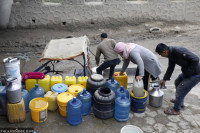Money
Nepal to set standards for chhurpi as export potential grows
In the last fiscal year, the country exported 1,646 tonnes of chhurpi, known in the West as dog chew, worth Rs3.18 billion.
Post Report
Nepal’s quality watchdog has proposed new standards for Chhurpi, in a move to make the fermented hard cheese meet international standards as its demand grows in the overseas market.
Chhurpi, a traditional product of the highlands, is a protein-rich cheese with a smoky flavour and hard consistency that becomes chewier the longer you gnaw at it.
This solid snack's uniquely challenging texture has been a favourite for decades for the people of eastern Nepal, eastern India, and Bhutan. Lately, American and Canadian pooches have grown a liking for the hard cheese made of yak milk, and traders can barely keep up with demand.
According to officials, the Department of Food Technology and Quality Control has requested the Ministry of Agriculture and Livestock Development for chhurpi’s sanitary and phytosanitary details to ensure that the food is safe to eat.
The ministry has sent the standards draft to notify the World Trade Organisation (WTO).
Food and agriculture exporters need to comply with a variety of protocols when accessing markets for their goods.
The sanitary and phytosanitary measures help protect producers and consumers against specific health and safety risks.
The WTO Agreement states that sanitary and phytosanitary measures cover all relevant laws, decrees, regulations, requirements and procedures, including end product criteria; processes and production methods; testing, inspection, and approval procedures; and quarantine treatments associated with the transport of the products, animals or plants.
It also includes packaging and labelling requirements directly related to food safety.
The Department of Food Technology and Quality Control said that if the WTO is satisfied with the new standards, it would be implemented after being published in the Nepal Gazette.
“It will take at least 60 days to get a response from the WTO, and it is in the process,” said Mohan Krishna Maharjan, spokesperson for the quality control department.
“The department is continuously preparing and updating standards of Nepali traditional food. We prepared the standard of chhurpi as it is one of the traditional foods of Nepal and is also becoming an exportable commodity,” Maharjan said.
Maharjan said the proposed standard will also be implemented in dog chew, which is used to feed dogs and cats in foreign countries.
In recent days, domestically produced dog chews have become one of the potential exportable items, with increasing exports making it important to ensure quality, standard, and safety, Maharjan said. The product is in demand as owners prefer to feed their pets on nutritionally rich chews rather than junk food.
The dog chew contains no added preservatives, colours or chemicals. It is prepared manually with milk and natural products using traditional techniques.
Chhurpi is prepared manually with milk and natural products using traditional techniques. Hard cheese or chhurpi making involves boiling the milk, separating the whey and then shaping and drying the remaining solids. The resulting hard cheese is sliced into sticks, let dry, and smoked for a month.
Officials say that importers mainly look at national regulations on imported products.
Once the sanitary and phytosanitary measures are adopted, producers who fail to adhere to the standards will be fined under the Food Act, said Maharjan. The legal punishment is Rs50,000 in fine or up to five years of imprisonment.
According to the proposed standards, it will be implemented in all chhurpi types prepared from the processed single or mixed milk of cow, yak and buffalo.
Chhurpi with milk fat of 5.0 percent or more should come under the high-fat chhurpi category.
The low-fat chhurpi should contain milk fat of less than 5 percent. The trend of consuming low-fat milk as dog chew has been increasing.
Chhurpi should be unadulterated and clean, with a good taste and smell. It should not contain fungus, pests, or decay.
Chhurpi should not contain any type of stone, sand, glass, plastic or its pieces, mud, or metal. It should also be free of human hair, straw, cloth, living or dead pests, \mice or any part, any other livestock dirt, and other debris.
The high and low milk fat chhurpi should contain moisture, not more than 14 percent, and crude milk protein should be at least 60 percent by dry weight.
The government should determine the maximum residue level of contaminants, toxins and residue in chhurpi.
The production, processing, packaging, handling, storage, and transportation of chhurpi should be according to the food purity guidelines determined by the Ministry of Agriculture and Livestock Development.
The packaging material used for chhurpi should be clean, dry, and food-grade with proper labelling, as determined by the Food Regulations.
The label should list the ingredients that have gone into the chhurpi.
Recently, dog chews made in the eastern highlands have become an unlikely contender for Nepal's top exports.
According to the Department of Customs' annual foreign trade report, Nepal exported 1,646 tonnes of dog chew worth Rs3.18 billion in the last fiscal year ending July 15. The exports, however, have dropped slightly due to the requirements of the export standards.
The country had exported 1,786 tonnes of dog chew worth Rs3.40 billion in the previous fiscal year 2022-23.
Nepali dog chews are mainly exported to the US, followed by Canada.
Nepal exported 1,435 tonnes of dog chew worth Rs2.76 billion to the US, while 1,238 tonnes worth Rs266.38 million were shipped to Canada.
Insiders say demand for dog chew rose sharply in the US and Canada after people bought more pet animals when forced to stay home during the Covid-19 lockdowns.




 7.12°C Kathmandu
7.12°C Kathmandu














